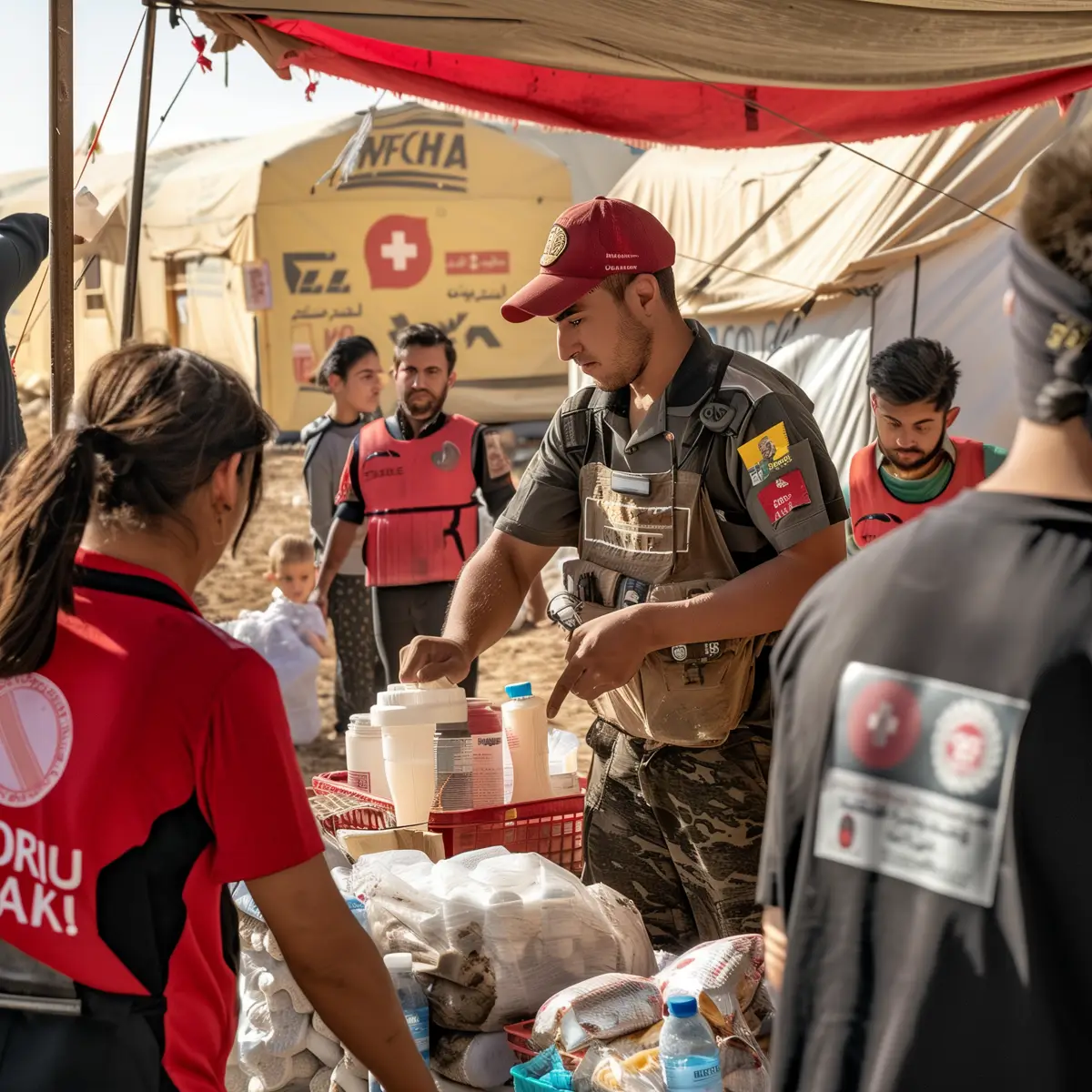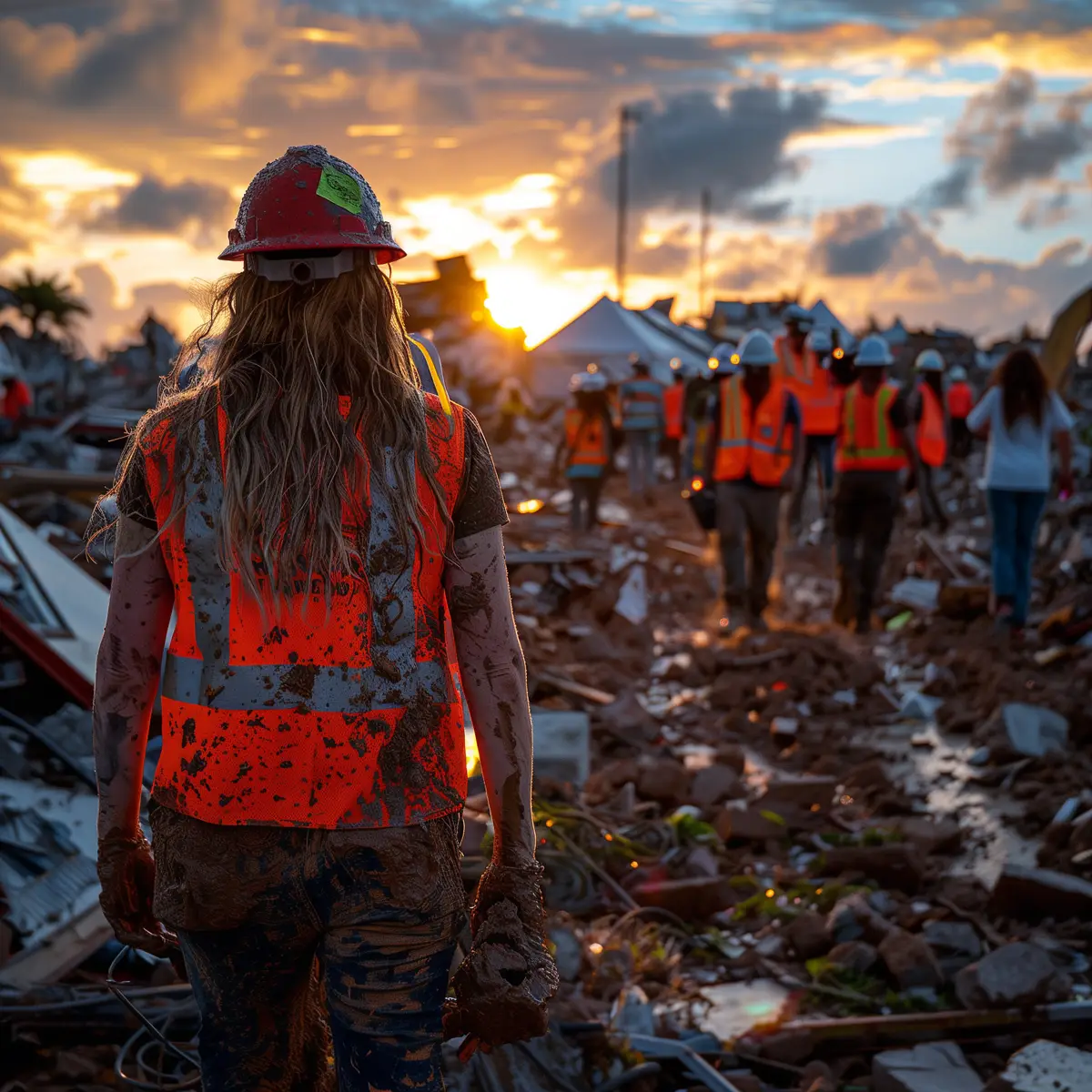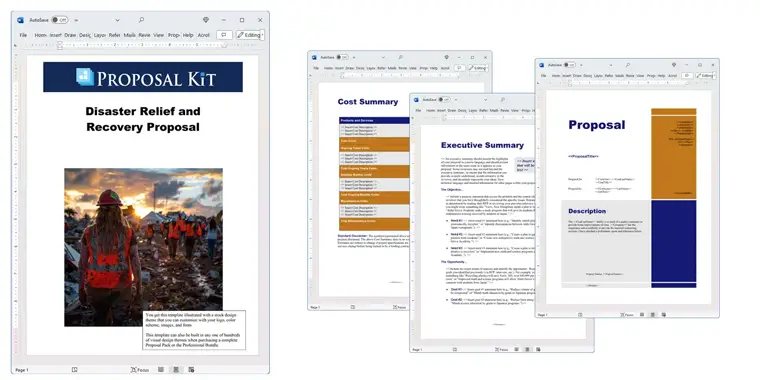How to write your Disaster Relief and Recovery Proposal
We include this 30 page layout with every Proposal Pack. If you want this template to have a different visual design theme than the one illustrated here, purchase any Proposal Pack design and create this template using the purchased design theme. This template is included in every Proposal Pack. If you get a Proposal Pack or the Professional, you can also make any variation of this template with different chapters to suit your needs.
We typically include more chapters in the templates than most people will need to give everyone more variety in the chapters they may need. You can trim down a long template by removing pages you do not need or combining multiple chapter topics into one page.
 DOWNLOADABLE, ONE-TIME COST, NO SUBSCRIPTION FEES
DOWNLOADABLE, ONE-TIME COST, NO SUBSCRIPTION FEESYou can also create countless variations of this document to suit your needs using the included library of 2200+ chapters if ordering a Proposal Pack or Professional.
 What Our Clients Say
What Our Clients SayProposal Pack Wizard is very helpful in organizing the individual section of an effective proposal. By breaking the sections into pieces , it makes the effort more doable. Really like this product."
TechSentials, Inc.
Related Article
Related Video
Related Templates
- Drone Delivery of Supplies in Disaster Area Proposal
- Humanitarian Aid Services Support Proposal
- OSHA Health and Safety Compliance Plan Proposal
- Site Safety Upgrades to Meet Regulations Proposal
- Business Continuity During Labor Shortages Proposal Template
- Emergency Preparation Project Proposal
- Business Continuity Services Proposal
- Disaster Preparation and Training Proposal
- EMS Onsite Services Proposal
- Food Aid Grant Project Proposal
- Meals To Go Service Proposal Template
- Popup Kitchen Community Support Funding Proposal
- Stockpiling Emergency Supplies Proposal
- Disaster Cleanup Services
- Safety Plan
- Insurance Coverage Services Proposal
- Insurance Quotation Proposal
What's the Best Way to Write Your Disaster Relief and Recovery Proposal?
When drafting a disaster relief and recovery proposal, the most effective solution is using the Proposal Kit template and software package. This powerful tool streamlines the proposal writing process, making it accessible for individuals regardless of their prior experience. Proposal Kit simplifies the proposal creation task by offering a comprehensive template library and a Wizard software program.
If you find yourself in need of writing such a proposal, whether for a small community project, a large-scale government initiative, or applying for federal disaster assistance you're not alone.
What Types of Projects Are Disaster Relief and Recovery Proposals Written For?
Writing a disaster relief and recovery proposal involves outlining plans and strategies for responding to disasters, mitigating their effects, and aiding in the recovery process. Such proposals are crucial for securing funding and support for projects aimed at helping communities withstand and rebound from catastrophic events. The types of projects that typically require a disaster relief and recovery proposal include:
- Emergency Shelter Operations
- Water Purification and Distribution
- Medical Assistance and Health Services Mobilization
- Infrastructure Repair and Reconstruction
- Psychological Support Services
- Disaster Preparedness Training Programs
- Long-term Housing Solutions
- Community Resilience Building Initiatives
- Resource Allocation for Emergency Response
- Technology Deployment for Disaster Management
Chapters this template is built with
Proposal Kit's template library offers thousands of customizable templates.
Incorporating these topics into a disaster relief and recovery proposal with the aid of Proposal Kit templates ensures a comprehensive, professional, and persuasive document, significantly enhancing the chances of securing the necessary funding and support.
These templates are available in Word format, making it easy for users to edit and then save as PDF files for delivery. The proposal is just one step in setting up the overall project, but it's a crucial one that Proposal Kit makes significantly easier.
Cover Letter
The cover letter serves as the initial contact point with the potential funder or client. It should briefly highlight the proposal's intent, express the organization's commitment to disaster relief and recovery, and invite the reader to review the detailed proposal. A well-written cover letter sets the tone for the proposal, indicating professionalism and earnestness.
Introduction
The introduction provides an overview of the organization or individual submitting the proposal, the specific disaster relief and recovery needs being addressed, and a brief outline of the proposed solution. This section should capture the reader's attention by conveying the urgency and importance of the proposed project.
Executive Summary
A practical executive summary briefly summarizes the proposal's key points, including the problem statement, proposed solution, expected outcomes, and the funding or resources required. It should be compelling enough to encourage the reader to explore the detailed proposal.
Cost Summary
The cost summary provides a clear and detailed breakdown of the project's financial requirements. This includes direct costs, such as materials and labor, and indirect costs, such as administrative expenses. Transparency and accuracy in the cost summary are crucial for building trust with potential funders.
Threats
Identifying potential threats and challenges that could impact the project is vital. This section should not only outline these risks but also present strategies for mitigating them, demonstrating foresight and preparedness.
Disaster Recovery Plan
The disaster recovery plan outlines the strategies and actions that will be taken to restore services and support to affected communities. It should detail the steps for rebuilding infrastructure, providing essential services, and supporting the community's return to normalcy.
Security Plan
Ensuring the safety of both the relief workers and the affected populations is paramount. The security plan should address potential security risks and describe measures to protect personnel, assets, and sensitive information.
Safety Plan
Similar to the security plan, the safety plan focuses on maintaining a safe environment for everyone involved in the disaster relief efforts. This includes health and safety protocols, emergency procedures, and risk mitigation practices.
Resource Allocation
This section details how resources, including funds, personnel, and materials, will be allocated to various aspects of the project. Effective resource allocation is critical for maximizing the impact of the relief efforts.
Coordination
Coordination involves the management of interactions between different stakeholders involved in disaster relief efforts, such as government agencies, non-profits, and community organizations. This section should outline the mechanisms for ensuring efficient collaboration and communication.
Assessment
Before implementing the proposed solution, a thorough assessment of the disaster's impact and the community's needs is essential. This section describes the methods and tools that will be used for conducting these assessments.
Fieldwork
Fieldwork is the on-the-ground execution of the disaster relief plan. This section explains how the proposal's objectives will be operationalized, detailing the deployment of teams, distribution of aid, and other activities.
Response Time
Rapid response can significantly affect the outcome of disaster relief efforts. This part of the proposal highlights the strategies for ensuring swift action following a disaster, including the pre-deployment of resources and quick decision-making processes.
Preparedness
Preparedness measures taken before a disaster strikes can significantly reduce its impact. This section should outline plans for disaster preparedness training, stockpiling supplies, and community education initiatives.
Rescue Systems
Describing the systems and technologies that will be employed for search and rescue operations is essential. This could include drones, communication systems, and specialized equipment.
Housing
Provision of temporary and long-term housing for displaced individuals is a critical component of disaster recovery. This section details plans for shelter operations, reconstruction of homes, and housing assistance programs.
Community
Rebuilding the community involves more than just physical reconstruction; it also includes supporting social cohesion and psychological recovery. This section should address strategies for community engagement and support.
Social Services
The proposal should outline the provision of social services, such as counseling, legal assistance, and social work, to support affected individuals and families in their recovery process.
Sources of Funds
Identifying potential sources of funding is crucial for the project's viability. This section lists the various funding streams being pursued, including grants, donations, and government support.
Uses of Funds
This part of the proposal delineates how the acquired funds will be used across different aspects of the project, ensuring transparency and accountability.
Funding Request
The funding request is a direct appeal for financial support, specifying the amount needed and how it will be utilized to achieve the proposal's objectives.
Recommendations
Offering well-considered recommendations can demonstrate your organization's expertise and commitment to successful disaster relief efforts. This section might suggest policy changes, improved practices, or other actions that could enhance disaster preparedness and recovery.
Services Provided
Detailing the specific services provided as part of the disaster relief effort helps clarify the proposal's scope. This could range from medical aid to debris removal and infrastructure repair.
Logistics
Effective logistics are crucial for disaster relief operations. This section outlines the plans for the procurement, transportation, and distribution of supplies and equipment.
Personnel
Describing the team involved in the project provides insight into the organization's capability to deliver on its promises. This includes the qualifications and roles of team members, as well as plans for recruiting and training additional personnel as needed.
Emergency Team Members
Highlighting the roles and expertise of emergency team members underscores the organization's readiness to respond to disasters. This includes first responders, medical professionals, and logistics experts.
Volunteering
Volunteers often play a vital role in disaster relief efforts. This section should discuss how volunteers will be recruited, trained, and deployed, as well as how their contributions will be integrated into the overall project plan.
Use cases for this template
Alexa's Story: A Small Business Owner's Triumph
When Alexa first embarked on her journey to secure a significant disaster recovery project, the challenges seemed insurmountable. As the owner of Resilient Recovery Solutions, a fledgling business in the disaster recovery industry, she was well aware of the skepticism her proposal might face. The task wasn't just about proving her company's capabilities; it was about convincing stakeholders that her small business could deliver results on par with, or better than, established players in the field.
With its comprehensive library of templates tailored for disaster recovery proposals, she found herself equipped to address every aspect of her proposal with confidence. The software's line item quoting database system was beneficial, allowing her to present a clear, detailed financial plan that underscored the value and efficiency of her proposed solutions.
Beyond the nuts and bolts of the proposal, Proposal Kit enabled Alexa to weave a narrative that highlighted her team's unique strengths. From innovative recovery strategies to a commitment to community support, the proposal resonated with the selection committee. In the end, Resilient Recovery Solutions was not just considered a capable contender; it was chosen to lead the project, marking a significant milestone for Alexa's business.
Jordan's Race Against Time
Jordan's predicament was a race against the clock. Tasked with developing a disaster recovery proposal in an exceptionally short period, the pressure was intense. The project was high stakes for Rapid Response Innovations, and failing to meet the deadline was not an option. The traditional approach to proposal writing - laborious and time-consuming - seemed impractical given the circumstances.
Using the Proposal Kit and an AI writing tool, Jordan found a powerful tool that accelerated proposal development. Proposal Kit's structured templates ensured that he covered all critical aspects of the proposal, from the executive summary to the detailed project plan, in a coherent and professional format. Meanwhile, the AI writing tool, guided by strategic prompts from Jordan, generated content that was both informative and persuasive, drawing from the company's website and other resources to enrich the proposal.
This innovative approach enabled Jordan to submit the proposal on time. It ensured that it stood out for its clarity, thoroughness, and compelling presentation of Rapid Response Innovations as the best choice for the project. The successful submission under such tight constraints was a testament to Jordan's resourcefulness and the robust capabilities of the Proposal Kit.
Casey's Global Mission
Casey faced a challenge of a different scale. The mission of the Global Relief Network was to extend disaster relief services across multiple countries, each with its unique challenges and requirements. Securing a grant that would fund such an expansive project required a proposal that was not only comprehensive but also compelling enough to convey the urgency and necessity of the initiative.
With Proposal Kit, Casey was able to structure her proposal to highlight the global scope of the project while addressing the specific needs of each country. The templates provided a foundation that she could customize to showcase the organization's capabilities, past successes, and the innovative solutions it planned to implement. Detailed sections on the logistics of resource allocation, coordination with local agencies, and the expected impact of the services provided painted a vivid picture of the project's potential.
The grant application, strengthened by the clarity and detail afforded by Proposal Kit, succeeded in capturing the attention of the funding body. Casey's effective articulation of the project's scope and impact, facilitated by the comprehensive templates, was pivotal in securing the funding necessary for the Global Relief Network to embark on its ambitious mission.
Whether facing the challenge of proving a small business's worth, meeting a nearly impossible deadline, or outlining a global initiative's broad scope, Proposal Kit provides the tools to transform daunting tasks into successes.
Conclusions and Recommendations
By providing a structured approach to proposal writing, combined with comprehensive support materials, Proposal Kit enables its users to write winning proposals that lead to funded projects and successful outcomes.
Also Known As
This template may also be referred to in different ways or be used in more specialized situations, such as:
- Emergency Response and Recovery Plan
- Crisis Relief and Rehabilitation Proposal
- Disaster Management and Recovery Strategy
- Post-Disaster Support Proposal
- Emergency Aid and Recovery Plan
- Disaster Recovery and Assistance Proposal
- Crisis Intervention and Recovery Plan
- Relief and Restoration Project Proposal
- Disaster Response and Recovery Framework
- Emergency Relief and Reconstruction Proposal
Abstract
 When constructing a proposal for disaster relief and recovery, it is important to have a framework that guides the process, ensuring it's efficient and comprehensive. The Proposal Kit template and software package facilitate this by providing structured guidance, making it accessible even for those with minimal experience. The primary aim of such proposals is to outline plans for responding to natural disasters and aiding in recovery, which includes securing funding and support for projects that help communities impacted by these events.
When constructing a proposal for disaster relief and recovery, it is important to have a framework that guides the process, ensuring it's efficient and comprehensive. The Proposal Kit template and software package facilitate this by providing structured guidance, making it accessible even for those with minimal experience. The primary aim of such proposals is to outline plans for responding to natural disasters and aiding in recovery, which includes securing funding and support for projects that help communities impacted by these events.
These projects can range from emergency shelter operations to long-term housing solutions and community resilience initiatives. Writing a successful proposal involves understanding the disaster recovery process and using recovery support functions, such as the recovery support functions, to ensure a shared understanding among federal agencies, local jurisdictions, tribal governments, and nongovernmental partners. This collaborative approach is crucial in rebuilding the capacity of local communities and ensuring timely recovery from federally declared disasters.
The National Disaster Recovery Framework (NDRF) established by the federal government plays a role in guiding the disaster recovery process. This framework emphasizes the importance of coordination among stakeholders, such as support agencies and other stakeholders, to address the priorities of economic development and community restoration. The first step in a successful disaster relief initiative is conducting a thorough assessment of the affected counties to identify their specific needs. This assessment informs the creation of a disaster recovery plan, which should detail the allocation of additional resources and the involvement of federal and support agencies to bolster local efforts. It is vital to integrate social services, infrastructure repair, and psychological support to ensure a holistic recovery. Access to federal assistance, like FEMA support, is critical for local jurisdictions to manage the aftermath of a storm. The proposal must also address potential threats and outline a security and safety plan to protect assets and ensure the safety of relief workers and communities. Effective logistics, resource allocation, and coordination with nongovernmental partners are necessary to support timely fieldwork and rescue operations. By using the resources and guidance offered by Proposal Kit, organizations can articulate a case to potential donors, thus enhancing the chances of securing the necessary funding to support long-term recovery efforts and strengthen community resilience.
 In the field of disaster recovery, having a robust and well-structured proposal is important for garnering the support and resources needed to aid in recovery efforts. The Proposal Kit template and software package offer a streamlined approach to writing such proposals, which are crucial for addressing the complex needs of communities affected by natural disasters. These proposals are designed to articulate a clear plan for using the National Disaster Recovery Framework (NDRF) to mobilize the necessary recovery support functions. Comprised of a number of recovery support functions, this framework guides local communities and federal agencies in the disaster recovery process, ensuring each stakeholder, including tribal governments and nongovernmental partners, has a shared understanding of their roles and responsibilities.
In the field of disaster recovery, having a robust and well-structured proposal is important for garnering the support and resources needed to aid in recovery efforts. The Proposal Kit template and software package offer a streamlined approach to writing such proposals, which are crucial for addressing the complex needs of communities affected by natural disasters. These proposals are designed to articulate a clear plan for using the National Disaster Recovery Framework (NDRF) to mobilize the necessary recovery support functions. Comprised of a number of recovery support functions, this framework guides local communities and federal agencies in the disaster recovery process, ensuring each stakeholder, including tribal governments and nongovernmental partners, has a shared understanding of their roles and responsibilities.
A well-rounded disaster relief proposal will cover various topics, such as the allocation of resources for emergency response, infrastructure rebuilding, and economic development. The federal government, through federally declared disasters, plays an integral role in providing support to local jurisdictions, facilitating access to additional resources and funding. Key components like the cover letter and executive summary of the proposal are vital in capturing the attention of potential funders and conveying the urgency of recovery efforts in counties impacted by disasters.
These proposals should also highlight the coordination mechanisms in place to ensure effective collaboration among federal and support agencies, local entities, and other stakeholders. This includes planning for the timely deployment of personnel and resources, establishing a security plan to safeguard both relief workers and the community, and setting up logistics for the efficient distribution of aid. A focus on preparedness, through disaster recovery training and community engagement, is important in minimizing the impact of future disasters.
 The intricate process of recovery also calls for a comprehensive assessment of both immediate and long-term community needs, with a detailed analysis of potential threats and capacity-building measures. Addressing these areas within the proposal not only strengthens the case for funding but also ensures that the recovery efforts are sustainable and effective in promoting long-term community resilience. Using tools like Proposal Kit, organizations can develop a document that aligns with the priorities established by the NDRF, ultimately leading to successful recovery outcomes and enhanced community readiness for future challenges.
The intricate process of recovery also calls for a comprehensive assessment of both immediate and long-term community needs, with a detailed analysis of potential threats and capacity-building measures. Addressing these areas within the proposal not only strengthens the case for funding but also ensures that the recovery efforts are sustainable and effective in promoting long-term community resilience. Using tools like Proposal Kit, organizations can develop a document that aligns with the priorities established by the NDRF, ultimately leading to successful recovery outcomes and enhanced community readiness for future challenges.
Frequently Asked Questions
What should be included in a disaster relief and recovery proposal?
A comprehensive disaster relief and recovery proposal should include an introduction, a situational analysis of the disaster, objectives of the relief and recovery efforts, a detailed plan of action, roles and responsibilities, resource requirements, a timeline for implementation, budget and funding sources, risk assessment and mitigation strategies, and monitoring and evaluation plans. Each section should provide clear and actionable information to address the disaster and aid in recovery effectively.
How do I assess the immediate and long-term needs of the affected community?
Assessing immediate and long-term needs involves conducting a thorough needs assessment, which includes collecting data on the extent of the damage, identifying affected populations, and understanding the specific needs for food, shelter, medical care, and other essential services. Long-term needs should focus on rebuilding infrastructure, restoring livelihoods, and ensuring sustainable recovery. Engage with local authorities, community leaders, and affected individuals to gather accurate and comprehensive information.
How can I ensure the proposal is appealing to potential donors and stakeholders?
To make the proposal appealing, clearly articulate the impact of the disaster and the urgent need for relief and recovery efforts. Highlight your organization's effectiveness and efficiency in managing similar projects, include compelling stories and testimonials from affected individuals, and provide a detailed budget that shows transparency and accountability. Emphasize the long-term benefits of the recovery plan and how it will help rebuild and strengthen the community.
What are the common challenges in implementing disaster relief and recovery efforts?
Common challenges include logistical issues, coordination among multiple stakeholders, limited resources, and potential security risks. Address these by outlining a clear coordination plan, detailing logistical arrangements, identifying potential partnerships, and including a robust risk management strategy. Explain how your organization will overcome these challenges through experience, strategic planning, and collaboration with local and international partners.
How do I measure the effectiveness and impact of the relief and recovery efforts?
Measuring effectiveness and impact involves setting clear, measurable objectives and using key performance indicators (KPIs) to track progress. Include a monitoring and evaluation (M&E) plan in the proposal that outlines how data will be collected, analyzed, and reported. Use qualitative and quantitative methods to assess outcomes, such as beneficiary feedback, improvements in living conditions, and the restoration of services and infrastructure. Regularly update stakeholders on progress and adjust the plan based on feedback and changing circumstances.
20% Off Discount
![]() Add To Cart This Word Template
Add To Cart This Word Template
 Add To Cart Proposal Pack for Any Business
Add To Cart Proposal Pack for Any Business
 Add To Cart Proposal Kit Professional
Add To Cart Proposal Kit Professional
 4.7 stars, based on 849 reviews
4.7 stars, based on 849 reviewsProposal Kit chapters used in this template
Cover Letter, Title Page, Table of Contents, Introduction, Executive Summary, Services Provided, Social Services, Preparedness, Threats, Assessment, Disaster Recovery Plan, Community, Fieldwork, Housing, Logistics, Coordination, Resource Allocation, Security Plan, Safety Plan, Rescue Systems, Response Time, Funding Request, Sources of Funds, Uses of Funds, Cost Summary, Recommendations, Emergency Team Members, Personnel, Volunteering, Back Page
Line Item Automated Chapters
If you purchase a Proposal Pack or the Professional Bundle, these proposal pages are generated using an automated line-item database in the included Wizard software.
Cost Summary, Funding Request
You use this proposal for
- General business proposal
- Non-technical proposal
- Project pitch proposal
- Non-government grant, non-profit, NGO proposal
- Security, safety, protection, investigation proposal
- Spiritual, church, community proposal
How to create this template with Proposal Pack Wizard
You can create this document using any of the logo-designed Proposal Packs. Pick any Proposal Pack with a logo design theme you like best; they will all work equally well. The Proposal Pack for Any Business is the pack with no extra added logos or colors - designed to be used plain or for you to customize with your logos and graphics.
The Proposal Pack design theme you purchase will determine the visual look of this template. The screenshot above only shows the plain generic design theme.
We include a library of chapters to be assembled based on your needs. All proposals are different and have different needs and goals. We designed Proposal Pack so you can customize the documents to suit your needs.
You will best create this document using the Proposal Pack Wizard - Expert Edition software to select this template and build it in the Proposal Pack logo design theme of your choice along with any desired customizations (such as adding additional chapters, removing unneeded chapters, changing the order of chapters, and importing your company logo). This template outlines a proposal for the described situation. Each user is responsible for typing in the actual content of the provided pages with their information to complete the proposal. Suggestions in the abstract may include features in higher-end packages and are facilitated by the selection of chapter templates to support the narrative of each proposal, which help guide the user in filling in the details.
The Wizard software's AI Writer will write the content of the pages of the template based on details provided for your company, client, project, financial details and other writing instructions. This will provide a personalized version of the template completely written and ready to edit.
Once finished, the AI Writer's Word-to-PowerPoint converter can transform your proposal, business plan, or other business documents into a PowerPoint slideshow. Save time and effort by letting the AI analyze every chapter to condense its content into talking points, visually matching the document, and providing a consistent package of presentation material with the click of a button.
You create this template using the Wizard software with an entire Proposal Pack library and software. We include the Expert Edition of the software in the Proposal Kit Professional. Microsoft Word for Windows is required to use the customizing software. You can also edit Word document templates in other office software such as Word for Mac. We will assist Mac users in assembling complex templates for their first project if they do not have the required platform to run the Wizard software.
How to Build Templates Featured on Proposal Kit Website
Many people find the Proposal Kit website after searching for a specific proposal. Once you've purchased and installed the software, how do you build that template you found in the first place? This video shows you how to build any proposal you see on the Proposal Kit website.
 Ian Lauder has been helping businesses write their proposals and contracts for two decades. Ian is the owner and founder of Proposal Kit, one of the original sources of business proposal and contract software products started in 1997.
Ian Lauder has been helping businesses write their proposals and contracts for two decades. Ian is the owner and founder of Proposal Kit, one of the original sources of business proposal and contract software products started in 1997.By Ian Lauder
 Published by Proposal Kit, Inc.
Published by Proposal Kit, Inc.


 Cart
Cart
 Get 20% off ordering today:
Get 20% off ordering today: 


 Facebook
Facebook YouTube
YouTube Bluesky
Bluesky Search Site
Search Site